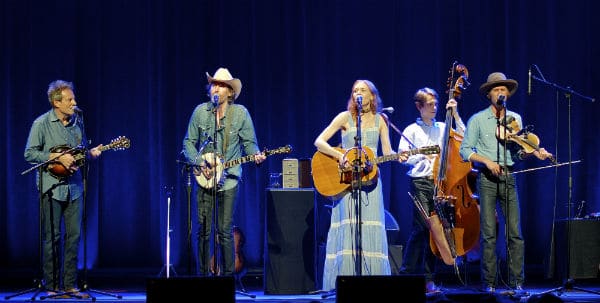
Dave Rawlings Machine at the Ryman Auditorium
Nashville, TN 6/27/14
Videos by American Songwriter
“There’s no better room in the world for string band music,” Gillian Welch said of the Ryman Auditorium during the concert there on Friday. And there’s no better band to play on that hallowed Nashville stage, home of the Grand Ole Opry in its heyday, than Dave Rawlings Machine. The Ryman is half-a-block from the neon-lit tourist mecca of Broadway, which is becoming increasingly indistinguishable from similar strips like Beale Street in Memphis and Sixth Street in Austin. Walking down Broadway, you’re as likely to hear a band blasting “Old Time Rock and Roll” as you are to hear the kind of country music that made Nashville famous. It’s ironic, then, that these country industry outsiders—Rawlings, Welch, John Paul Jones on mandolin (yes, that John Paul Jones), Willie Watson of Old Crow Medicine Show on guitar, and Paul Kowert of the Punch Brothers on stand-up bass—play music that’s true to the Ryman’s heritage, while contemporary “country” stars purvey formulaic stadium rock with pedal steel and a hokey accent.
It’s generous of Welch to play backup to her long-time partner, Rawlings, who immediately acknowledged the audience’s reverence for Welch by having her sing the first song, “Will the Circle Be Unbroken,” an ancient Opry favorite. That generous spirit permeated the entire performance, as Rawlings called on Welch to sing a hefty portion of the tunes, with Watson and Kowert also singing a few, and the crowd responding with emphatic warmth and affection. Jones, the reserved bass player for Led Zeppelin, is an accomplished mandolin player, and the numerous extended instrumental sections generally consisted of complex, and often thrilling, interactions between Jones’ mandolin and Rawlings’ wildly inventive guitar. Rawlings’ voice was in good form, and the three, four, and five part harmonies were sublime and moving, but it’s no secret that Rawlings’ greatest musical contribution is his guitar work, emanating in cascading runs from the circling neck of his 1935 Epiphone Olympic archtop, a grinning wizard in an oversized hat conjuring apparitions. In particular, the instrumental section in “Bells of Harlem” transcended the label “guitar solo,” coming across as a kind of spontaneous campfire symphony.
While Rawlings spent much of the night bouncing on the balls of his feet, eyes closed in ecstatic rapture, Gillian Welch’s simultaneously ethereal and deeply rooted presence added a sense of gravitas and mystery to the proceedings, her head often bent down as if listening intently to the music, or possibly to the rhythms of the earth. When she sang, her modest calmness filled the room, inducing a steady, hypnotic self-forgetting in the audience entirely different from the effusive enthusiasm sparked by Rawlings’ guitar explorations, which repeatedly flirted with disaster and, just as the melody seemed headed for a cliff, took sharp right turns, calamity averted and revelation achieved.
The setlist was seamless, drawn primarily from Rawlings’ 2009 album, A Friend of a Friend: Bright Eyes’ “Method Acting” morphed into Neil Young’s “Cortez the Killer,” Bob Dylan’s “Queen Jane Approximately,” “The Weight” by The Band, and Led Zeppelin’s “Going to California” (with Jones on mandolin, just like the original) slotted in nicely with Welch’s “One More Dollar,” old folk songs like “Dry Bones,” “Goin’ Down the Road Feeling Bad,” “Monkey and the Engineer,” and “Go To Sleep, Little Baby,” and classic-sounding Rawlings co-writes with Welch (“Ruby,” “Sweet Tooth,” “It’s Too Easy,” “Bells of Harlem”), Ryan Adams (“To Be Young”), and Ketch Secor of Old Crow Medicine Show (“I Hear Them All”).
The audience was composed mostly of hip, slightly graying men in western shirts and pretty ladies in country dresses, many of them obviously musicians, listening attentively and hollering at all the right moments. Then there was the one beefy frat boy in a white tee-shirt and baseball cap, dead-center in the third row, inappropriately rocking out and occasionally throwing his hat up in the air. But the music was so pure, and the feeling so good, that by the end of the evening, you couldn’t help but sympathize with him, a big, joyful baby rocked, like all of us, in the cradle of this cosmic American music.
Photo: Jennifer Silver

One Comment
Leave a Reply